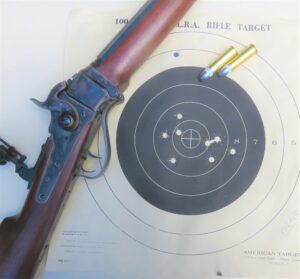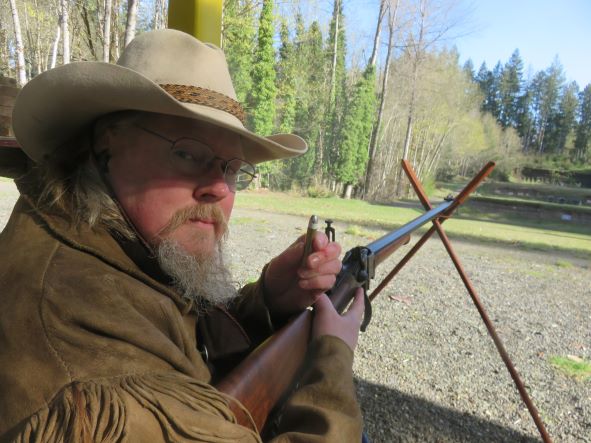
By Mike Nesbitt | Contributing Editor
Every year the Black River Buffalo Runners host a special shooting match, mainly for “buffalo rifles” featuring black powder loads with paper patched bullets.
Other styles of cast bullets are not forbidden in this match but the scores made while shooting the paper patched bullets are awarded with priority over the scores made with those “other bullets.” This gives us a very good look back in shooting history to when almost all sporting and target cartridges intended for single shot rifles were loaded with paper patched bullets.
The purpose of the paper patch is a rather simple one. The paper prevented the lead bullets from touching the inside of the rifle’s barrel, reducing the chance of “leading” in the bore. Thus, those patched bullets were our first jacketed bullets and the primary purpose for a modern bullet’s copper jacket is the very same, to reduce or prevent leading.
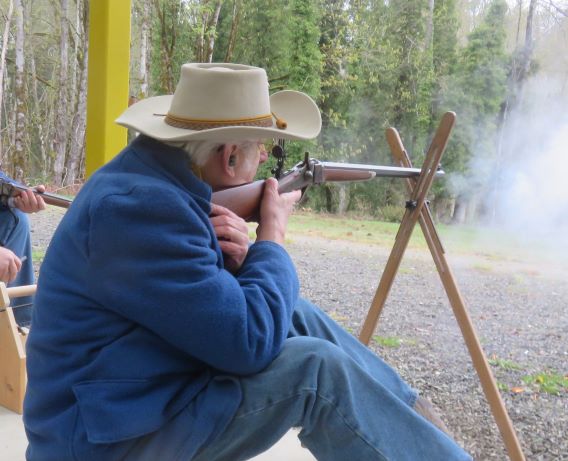
Adding the paper patch to a bullet is rather simple, or I wouldn’t be able to do it. Bullets designed to be patched are generally smooth sided, sometimes called “slicks,” and they are, also generally, smaller in diameter than the grooved and lubricated bullets. The thickness of the paper patch, usually two complete wraps, must be considered and the soft lead bullets do obturate (get fatter) as they are accelerated down the barrel when the rifle is fired.
The two main methods of paper patching are to add the patch while it is wet or to wrap the bullet with a dry patch. I favor the wet method and I’ve been doing that now for over 40 years.
That was an extremely brief description of patching a bullet. After all, there are books written about this subject. At this time, I don’t want to be more detailed about applying the paper patches but I can, especially if the interest is out there. If more detail about paper patching bullets is called for, just let me know and another story with “how to do” will follow.
Our course of fire for this match involves just two bullseye targets, one at 100 yards and another at 200 yards. Yes, paper patched bullets made their reputation by shooting much farther distances but at 200 yards we are at the limit of the range at our shooting club. Our distances fall into the “short range” category but such targets can still be very challenging. We shoot ten shots at each target, fired from the sitting position while resting the rifle’s barrel over cross-sticks.
My rifle for this match was the ’74 “Hartford Model” Sharps, made by C. Sharps Arms, in .50/70 caliber, the gun I call my “Moonbeam.” This “cannon” has a 30-inch barrel and the rifle weighs 13 pounds. While the .50/70 doesn’t “crack” like the smaller bores, I like to say those smaller calibers don’t “boom” like the .50s.
My load included 65 grains of Olde Eynsford 1 1/2F powder under a .030 wad, then 1/8th-inch of tallow-based lubricant, topped off by a 505-grain patched bullet. I’ve had this rifle just under a year and at this match I was competing with it while using paper patched bullets for the first time.
Jerry Mayo, my shooting partner at this event, suggested that we get a “group picture” of our paper patched cartridges before the shooting got underway. That was a good idea and the picture was quickly taken, after gathering one cartridge from each paper patch shooter plus adding two more cartridges just for show.
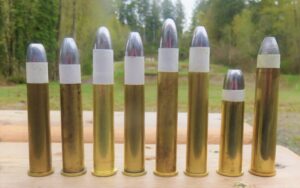
When the shooting got started, I spotted for Jerry and he began with his 200-yard target. I actually wanted to shoot after Jerry had one target out of the way because the morning haze had not completely lifted and my eyes hoped for brighter light, after the sun had burned through some light clouds. Jerry started with his 200-yard target simply because his sights were already set for that distance. All targets were posted at both distances and it is simply the shooters’ choice as were to begin.
Following Jerry’s ten shots at 200 yards, we traded places and I sat down to take my shots at the 100-yard target. My first couple of shots did very well and I was pleased with their hits. Then I got careless… Either smoke from the shot of a shooter next to me or something obscured my target as I was squeezing off the shot. I should have paused to wait for a clean sight picture. But I thought I was still “on” with the bullseye right in the middle of the front aperture, so I fired. That bullet only clipped the bottom of the paper resulting in a miss with no score. All I could do then was to be a good sport about it and keep going.
My other shots all pleased me, all it the black except one. I might grumble for years about dropping the possible 10 points with that missed shot but at the same time I must be rather pleased with my 100-yard score which was a 79 out of 100.
Then Jerry shot again while I spotted for his target, at 100 yards. There are advantages to having a partner spotting your target, although some shooters do prefer to spot their own shots. It is faster if you spot your own target but our group of shooters had plenty of time. And that gave me just enough time to clean my rifle in preparation to shooting my 200-yard target as well as adjusting my rear sight for the longer distance.
Jerry was wiping his bore between shots, as all of our shooters using paper patched bullets were doing. Wiping the bore between shots adds to the consistency of shooting because each bullet travels down a clean barrel. Several paper patch bullet shooters do not add any lube to their loads when preparing ammunition for target shooting. The lube in the load helps keep the fouling soft which is most beneficial for the following shot, so lube in the load, under the paper patched bullet, is most wanted for hunting loads. I had lube in my loads but for shooting in the match I wiped my bore between shots anyway.
My first shot at 200 yards told me my sight setting was good and everything was as it should be, I scored a 10 at 6 o’clock. The other nine shots followed, doing well and with only one shot straying out of the black. I was quite pleased when the scorekeepers told me my 200-yard efforts brought me 88 points. That put me in second place.
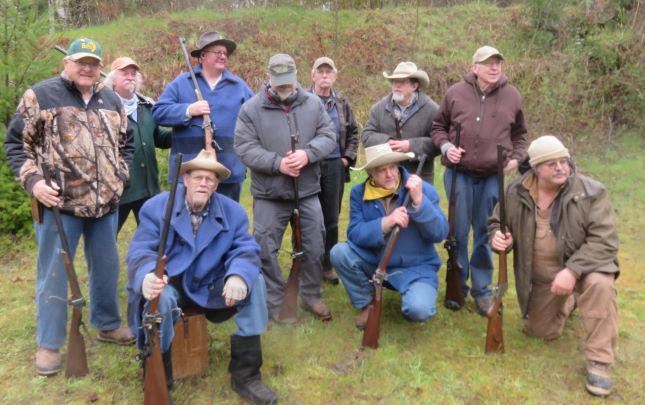
Our top shooter was Allen Cunniff and he was shooting his favorite and beautiful C. Sharps Arms Model 1874 Sporting Rifle in .45/70 caliber. Allen’s ammunition actually used 72½ grains of Swiss 1½ Fg powder under two .060” Walters’ fiber wads which were beneath the bullet. That bullet was a dual diameter paper patch design from Steve Brooks’ Tru-Bore Bullet Moulds. No lube was used in his target loads so Allen must wipe the bore between shots. His combined score for the day was a 181-X.
Allen’s high score put him first in line for our awards. As you can tell, we use the aggregate score rather than awarding each target and our prizes are usually either some meats or items for shooters’ needs. Sometimes those “shooters’ needs” are just a hat pin or maybe books on buffalo hunting. The prizes aren’t great in value but they certainly are appreciated and every shooter gets an award. When Bob DeLisle, the match director, called my name for 2nd place, I stepped to the prize table and selected a fine summer sausage. That makes “Moonbeam” a real meat-maker!

